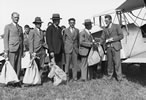Uncomfortable travel
Coach travel was uncomfortable. Sarah Courage described the effects of a trip from Kaiapoi to Leithfield: ‘My arms and shoulders for days afterwards … were all the colours of the rainbow; while my vital organs felt as if they were getting mixed up and entangled together.’1
Sad end for star
One poignant coach drowning was that of talented tightrope dancer and magician Jane Whiteside in 1875. Crossing the Waitaki River, most of the Oxford Combination Troupe walked over the bridge, but she remained in the coach. It capsized and she was drowned – aged 19, newly married, and having just become a star.
Passengers often had to get out of the coach to cross rivers, as few bridges had been built. On the Napier–Wellington route in the early 1870s, they crossed the Manawatū River in a basket, then took a second coach to the base of the gorge, and traversed the river again by canoe, before completing the journey by coach.
Dangerous travel
Coach travel was dangerous. Even though the horses were specially chosen and trained, they could shy or bolt, and tip the coach on its side. Coaches sometimes fell over cliffs or were blown off them. But the 19th-century ‘road toll’ was mainly from drowning while crossing unbridged rivers.
Sentenced to a coach trip
A coach trip was used as a law and order device by Dunedin police in 1869. Prostitute Barbara Weldon had appeared in court many times on charges of drunkenness and disorderly conduct when the authorities gave her a one-way coach ticket to Hokitika. There she was soon charged with using obscene language in a public place. She spent the rest of her life in and out of jail.
Coach drivers
Coach drivers were known as ‘whips’. Many won reputations as cheery daredevils who liked danger. In a 1940s publication, the early coach driver was romanticised as ‘usually a fine burly man, fearless and dauntless, caring not for danger be it flood, bushrangers or intricate roads hewn out of forest, beset with boulders or tree-stumps: the greater the danger, the better he seemed to like it.
‘Whips’ had a tough life. Hugh Craig began driving for Cobb & Co in his teens in the 1860s. The Tuapeka Times described how he was often ‘on the coach for 16 to 18 hours per diem, driving on the worst road in the world [between Clyde and Lawrence] and half of that time by lamp light …’3 Craig would reach Lawrence after 10 p.m., but set out again at 5 a.m., even in bad weather.
Unimpressive accommodation
Writer Anthony Trollope travelled by coach on his 1873 New Zealand trip. He was unimpressed by the accommodation houses: ‘The inns at which we were stopped were not delightful. The rooms formed of corrugated iron are small and every word uttered in the house can be heard throughout it, as throughout a shed put up without divisions.’4
Coaching houses
Accommodation houses were sited along coach routes, to suit horses as much as passengers. Horses had to be changed every couple of hours, and needed stables and blacksmiths. Many accommodation houses were very basic, often with narrow stretchers, rather than beds, packed tightly into small rooms.
When a coach service began along the coast between Wellington and Whanganui in 1858, Hector McDonald and his wife Agnes built an accommodation house and changing stables at the mouth of the Hōkio Stream.

